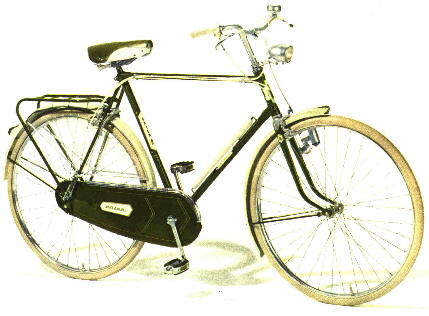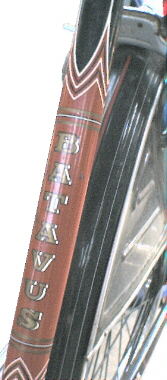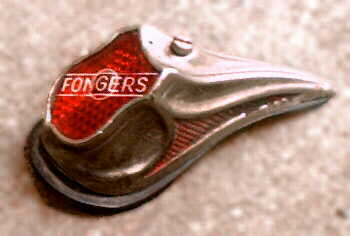 |

|

|
Bicycle models from the end of the 1950's to the
beginning of the 1960's |
 |
| Introduction

Many fans of old bicycles believe that the older the bicycle, the more interesting it is.
Because you can still see a large number of bicycles from the 1950's and 1960's on the
streets, they are not seen as anything special. This is unjustified because the classic
Dutch models were produced until at least 1965 while at the same time the modern bicycle
was being developed. In this article I would like to discuss the development of the
classic Dutch bike in the years 1957 to 1965. First however, a brief look at the prior
years.
1945 to
1956 models

The Dutch bicycle industry was greatly damaged during WWII. The occupation forces
ransacked many companies so that the business had to be rebuilt from the ground up.
Because of the scarcity of materials, only a minimum number of pieces could be produced.
There was not much room for innovation, so the models of the 1930's were continued. These
pre-war models dominated production until about 1957. These were the classic tour bicycles
for men and women with the wheel size of 28 X 1 1/2 inches which was almost
always painted in the standard color of black (other colors could be delivered for a
surcharge).

The first post-war brochures were not published until the
beginning of the 1950's (Burgers 1953, Gazelle 1951). During these years a couple of new
sport models appeared (tire size 28 X 1 5/8 inches X 1 3/8 inches,
narrower mudguards, aluminum rims). These were however, merely variations of the classic
models. In this area, the Netherlands were certainly not leaders; in England, for example,
sport bicycles were increasingly gaining in popularity since the 1930's.

With the advent of the moped and the car, production
increased. Since about 1957, new models suddenly appeared on the market.
|

Union "Vederlicht-Moment" (1962)
1957 to
1965 new models

In 1957 and 1958, all well-known brands introduced different new models at the same time.
These were characterized by:

 - 26
inch wheels, short wheel base, narrower tires (1 3/8 inches), - 26
inch wheels, short wheel base, narrower tires (1 3/8 inches),
- Modernized frame (lugs with artistic shapes, narrower mudguards; some ladies bicycles
had new frames (Simplex, Fongers),
- new basic colors (green, red, blue, grey),
- Rich decoration (use of color accents on frames and mudguards, richness of lines, chrome
stripes, mudguard figurines),
- Other accessories (decorated chain case, white handgrips, "baroque" rear
lights, white brake cables, aluminum rim brakes, two-colored seats, low steering bars with
most often loose handlebars),
- Appealing names (Batavus Flying Arrow Splendid Sport, Union Vederlicht de Luxe, Gazelle
Grand Sport).

In short, these were smaller bicycles with a snappy
appearance for those times. Gazelle described this in their 1963 brochure like this:
|
In this new Gazelle brochure you will find
the new Gazelle collection. This is a series of models that are adapted to the swing and
fire of this time; with snazzy colors, sparkling young exuberance, snappy line design...
style and spirit radiate everywhere. |
Sales drastically
increased in these years of a climaxing cold war, despite growing competition by other
means of transportation.

The modern outer appearance of these models can be seen in
cars and mopeds as well. The bicycle attempted to polish up its slightly dusty image with
the new line of products, which did succeed partially. At the same time, a lot of the old
producers perished, last but not least because of the requirement of huge investments in
order to switch over to more modern selection and earnings were declining because of
increasing competition and growing production costs. In a sense, the wave of modernization
achieved a separation of the good from the bad within the Dutch bicycle industry.
|
 The trend of the
"colorful", smaller bicycles was relatively short-lived and with most brands,
ended after 1965-66. In these years even the last producers stopped production of typical
classics such as the carrier bicycles or bicycles with cross frames. The trend of the
"colorful", smaller bicycles was relatively short-lived and with most brands,
ended after 1965-66. In these years even the last producers stopped production of typical
classics such as the carrier bicycles or bicycles with cross frames.

After these times I believe that the great boredom settled
in with the Dutch bicycle models. Touring and sport bicycles were offered in the colors of
black, green and brown with no remarkable details and often with identical not brand
specific parts. The quality of the bicycles from the 1970's and early 1980's was not
always convincing.

I want to claim that interesting bicycles were built in the
Netherlands until 1966 and that in that respect it became quiet after that for a long
time.1957
to 1965 models as collectors' items

So far the models described here are in general not considered worth collecting. It
appears to me, however, that a greater interest in bicycles from this time period should
be appropriate. We are dealing with a very characteristic series of models, which was made
for only a short time while at the same time the bicycles were of good quality. By now
they are around 40 years old and require conservation, especially since the specific parts
are hard to find or not to be found at all.
|

Fongers rear light, as of app. 1957 |
| This
page is an edited version of an article by Jos Rietveld, which appeared
in the club news of the bicycle club "De oude Fiets", Nr. 4/1999. This
information was translated by Anja Mancano, U.S.A. Thank you, Anja Mancano and
Marty Morris! |
Copyright by Jos
Rietveld, (c) 2000
All rights reserved.

Last update: 05/24/2000
|